 If
you click the "Household" task in the Quick Create task category
on the CRM360®
and Donor360®
screens, a blank Household Speed Form will open and the constituent's
information will NOT default.
If
you click the "Household" task in the Quick Create task category
on the CRM360®
and Donor360®
screens, a blank Household Speed Form will open and the constituent's
information will NOT default.
If you want to create a household but do not know of any household members, you can still create the household.
If none of the household members existed in Personify, when you save the household record, the system will create a new HOME address record owned by the head of household, create a linked HOME address records for non-head-of-household members, and update the household record with address ID of HOME address.
 If
you click the "Household" task in the Quick Create task category
on the CRM360®
and Donor360®
screens, a blank Household Speed Form will open and the constituent's
information will NOT default.
If
you click the "Household" task in the Quick Create task category
on the CRM360®
and Donor360®
screens, a blank Household Speed Form will open and the constituent's
information will NOT default.
To create a household from an existing constituent:
1. Open the Household Speed Form using one of the following ways:
· From the Household360™ search screen, click Create New Household.
· From the CRM360 or Donor360 search screen, click Create New Household.
· From the Quick Create task category on the CRM360 or Donor360 detail screen, click Household.
The Create
New Household Member screen displays, as shown below.
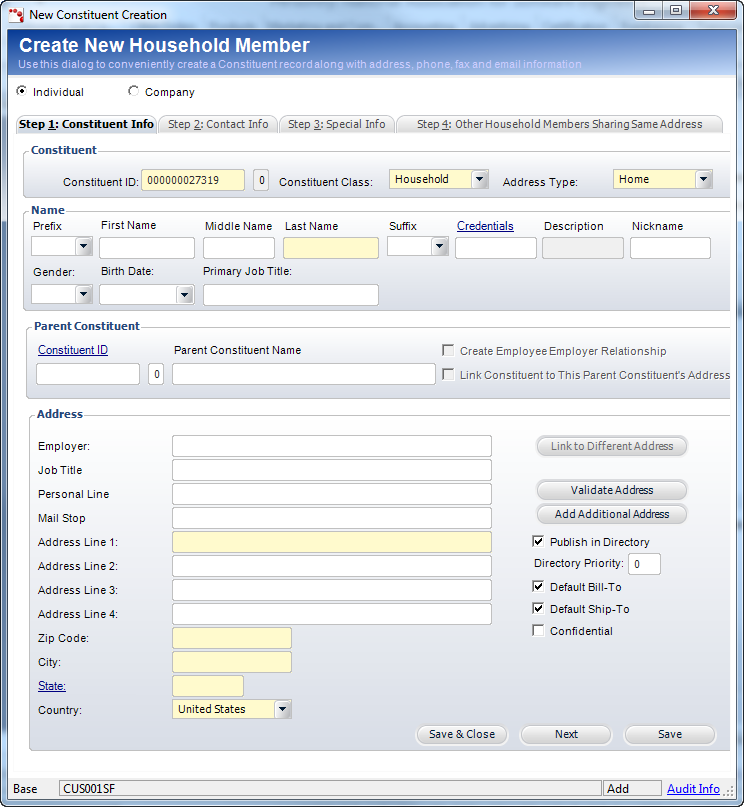
2. The Constituent ID is generated automatically, but can be changed if desired.
3. The Constituent Class defaults to "Household". Do not change this.
4. Select the household
Address Type.
By default, Home is selected. The values in this drop-down menu are populated
based on the non-fixed ADDRESS_TYPE
system type for the CUS subsystem.
5. Enter
the name of the household in the Last Name field.
This is a required field.
6. Enter the constituent's Address Line 1.
 Although
the address fields are required, if you selected the Address Type "BLANK",
the system will allow you to save the new constituent without entering
an address.
Although
the address fields are required, if you selected the Address Type "BLANK",
the system will allow you to save the new constituent without entering
an address.
7. Enter Address Line 2, Address Line 3, and/or Address Line 4, if necessary.
8. Enter the constituent's
Zip Code.
If more than one city exists for the entered zip code, a pop-up will display
from which you can select the appropriate city.
9. If the system found the zip code entered, the City and State fields will be automatically populated. Otherwise, enter the City and click the State link to search for and select the appropriate state.
10. Enter the County, if necessary.
11. Select the Country from the drop-down menu.
![]() When
an address is created for a constituent that owns the address, an entry
is created in the CUS_Address_Details table and the CUS_Address table.
When a linked address is created for a constituent, an entry is created
in the CUS_Address_Details table. You cannot link an address for an individual
once an unlinked address is saved because the CUS_Address table will not
be properly updated.
When
an address is created for a constituent that owns the address, an entry
is created in the CUS_Address_Details table and the CUS_Address table.
When a linked address is created for a constituent, an entry is created
in the CUS_Address_Details table. You cannot link an address for an individual
once an unlinked address is saved because the CUS_Address table will not
be properly updated.
12. If the new constituent's
information should be published in any base directory reports, whether
printed or published on the Web (e.g., XBT1202), select the Publish
in Directory checkbox.
When unchecked, the e-Business Member Directory web part excludes this
new customer information.
13. Enter the priority in which the address will be listed in the directory in the Directory Priority field.
14. By default, the
Default Bill-to checkbox is checked.
At least one address must be designated as the default bill-to address.
Since this is the constituent's first address in Personify, this checkbox
must be selected. Once the constituent is added to Personify, you can
add
an additional address and designate which of the two is the default
bill-to address on all orders for this constituent.
15. By default the
Default Ship-to checkbox is checked.
At least one address must be designated as the default ship-to address.
Since this is the constituent's first address in Personify, this checkbox
must be selected. Once the constituent is added to Personify, you can
add
an additional address and designate which of the two is the default
ship-to address on all orders for this constituent.
16. If the new constituent does NOT want their address to display on base roster reports (e.g., MBR1212PE), select the Confidential checkbox.
![]() When
defining contact information for a constituent, phone, email, web/social
media, and fax communication methods can be marked as “Include in Directory”.
Additionally, address communication
methods can be marked as “Confidential”. In the back office, all online
roster and directory reports where the last character in the report name
is “E” (for external), respect the “Confidential” and “Include in Directory”
definition for the listed constituents’ communication methods. For example,
if John Smith has his personal mobile phone number marked as not to be
included in the directory, that number will not be included in the MBR1200PE
report.
When
defining contact information for a constituent, phone, email, web/social
media, and fax communication methods can be marked as “Include in Directory”.
Additionally, address communication
methods can be marked as “Confidential”. In the back office, all online
roster and directory reports where the last character in the report name
is “E” (for external), respect the “Confidential” and “Include in Directory”
definition for the listed constituents’ communication methods. For example,
if John Smith has his personal mobile phone number marked as not to be
included in the directory, that number will not be included in the MBR1200PE
report.
For
example, MBR1200CE and MBR1200PE. MBR1200CE means it is a report that
lists companies first (hence the “C” in MBR1200CE), then the employees,
and finally, it is an external report (hence the “E” in MBR1200CE).
This
means that its intended audience is people outside the organization. MBR1200PE
means it is a report that lists individuals (hence the “P” for “professionals”
in MBR1200PE), and it
is intended to be viewed by people outside the organization (hence the
“E” for “external” in MBR1200PE).
The confidential flag is ignored on internal reports, which are reports
that have an “I” as the last character in their name (e.g., MBR1200CI and
MBR1200PI).
The “confidential” flag is also respected in the mobile member directory.
17. Click
Validate Address.
The Address Validation screen displays with the status of the validation.
Click Accept. See Validating
a Customer Address for more information.
18. If
you do not know any more information about the household, skip to step
35. Otherwise, click Next to proceed.
The Contact Info tab displays, as shown below.
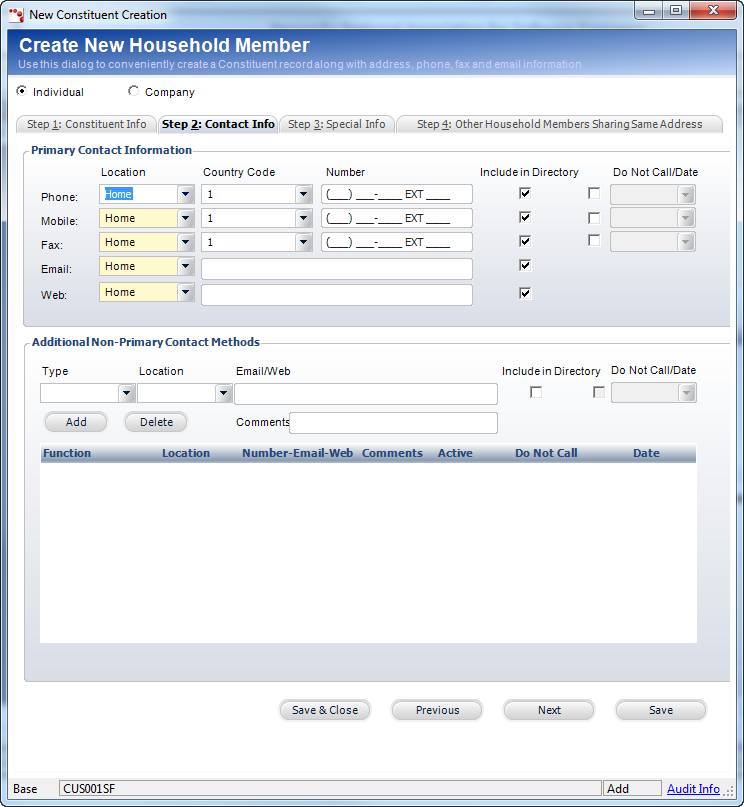
19. On the Contact Info tab, enter the contact's information, including Location, Country Code, and Number. The options include:
· Phone
· Mobile
· Fax
 For
more information on the default SSO settings when creating a new constituent,
please see Customer
Creation and SSO.
For
more information on the default SSO settings when creating a new constituent,
please see Customer
Creation and SSO.
· Web
20. Check the Include in Directory checkbox next
to the appropriate contact information, if necessary.
When checked, this indicates the new constituent gives permission to publish
the selected contact information.
21. Check the Do
Not Call checkbox next to the appropriate contact information, if
necessary.
Today’s date is automatically selected as the start date in which the contact
information cannot be called. The contact information cannot be called
for purposes of soliciting or promoting a product, service, membership,
and etc. If this checkbox is selected, "On Do-Not-Call Registry"
will display to the right of the contact method on the Contact
Information screen in CRM360, as highlighted below.

22. In the Additional
Non-Primary Contacts Methods section, select the Type from the
drop-down, fill out the appropriate fields, and click Add.
The fields in this section change depending on the Type selected. You can
also select whether you want to include the contact in the directory.
Once you add the contact, you can select the Do Not Call checkbox in the
table cell.
23. Click Next.
The Special Info tab displays, as shown below.
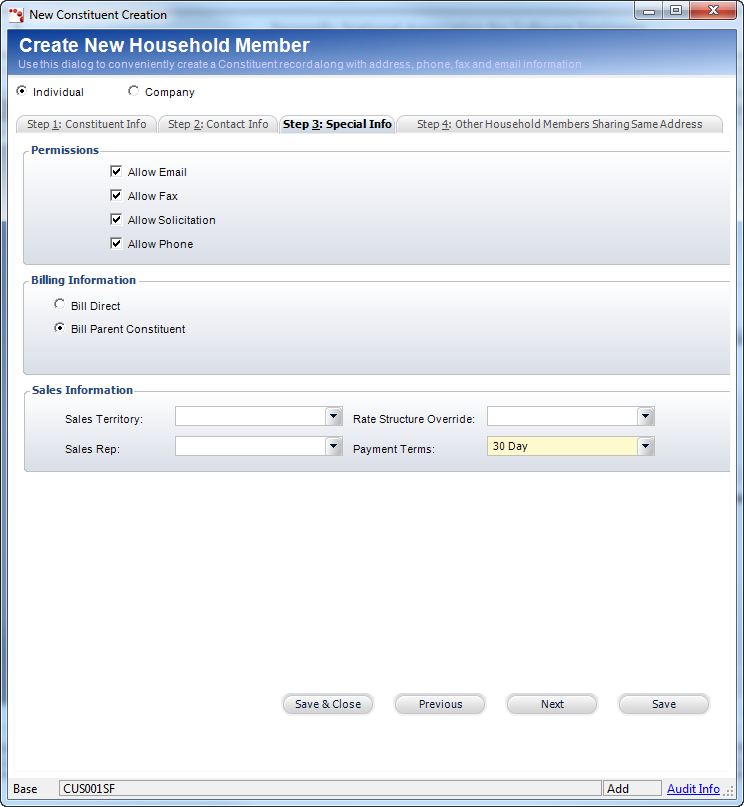
24. On the Special Info tab, select the appropriate permissions. The options include:
· Allow
Email – When checked, it indicates emailed communications can be sent
to this constituent. When unchecked, no emailed communications can be
sent to this constituent with the exception of automated system notifications.
If this checkbox is unchecked, "Do Not Solicit" will display
in red text to the right of the Email communication method on the Contact Information screen
in CRM360, as shown below.

· Allow
Fax – When checked, it indicates faxed communications can be sent
to this constituent. When unchecked, no faxed communications can be sent
to this customer, regardless of whether the communication is considered
promotional solicitation or not. If this checkbox is unchecked, "Do
Not Solicit" will display in red text to the right of the Fax communication
method on the Contact Information
screen in CRM360, as shown below.

· Allow
Solicitation – When checked, it indicates solicitations can be sent
to this constituent. If this checkbox is unchecked, the "Allow All
Solicitation" checkbox (highlighted below) will be unchecked and
"Do Not Solicit" will display in red text to the right of each
communication method on the Contact
Information screen in CRM360, as shown below.
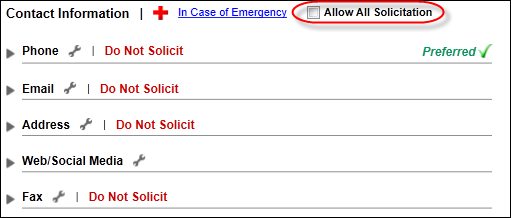
· Allow
Phone – When checked, it indicates the constituent can receive phone
calls. If this checkbox is unchecked, "Do Not Solicit" will
display in red text to the right of the Phone communication method on
the Contact
Information screen in CRM360, as shown below.
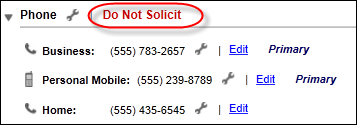
25. From the Billing Information section, select the appropriate billing information method either by Bill Direct or Bill Parent Constituent.
26. From the Sales Information section, select the Sales Territory, Sales Rep, Rate Structure Override, and Payment Terms
27. Click Next.
![]() You
must save the constituent before proceeding to the next tab. If you have
not yet validated the address, the Address Validation screen displays.
See Validating
a Customer Address for more information.
You
must save the constituent before proceeding to the next tab. If you have
not yet validated the address, the Address Validation screen displays.
See Validating
a Customer Address for more information.
The Other
Household Members Sharing Same Address tab displays, as shown below.
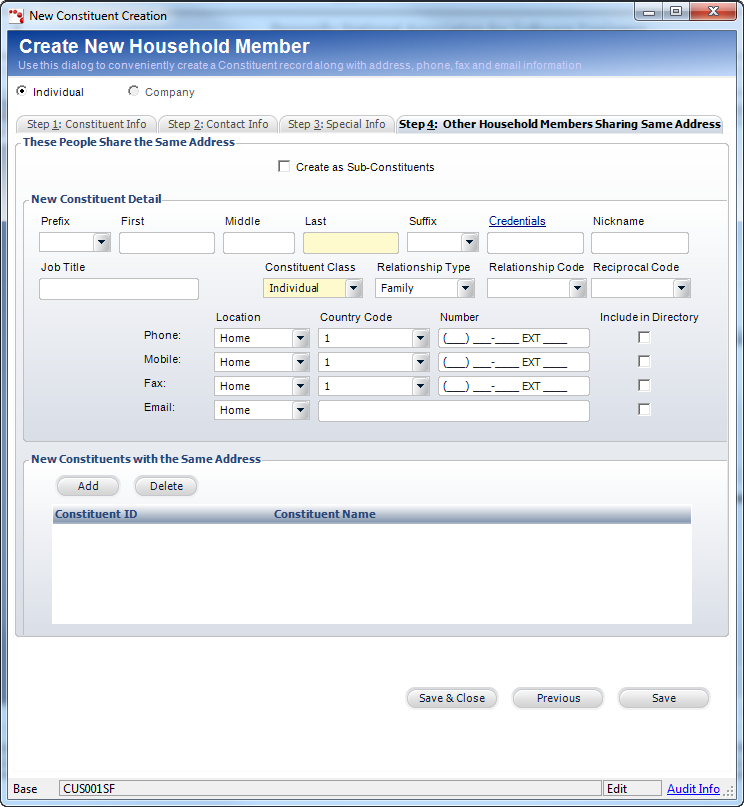
28. On the Shared Addresses tab, select whether you want to Create as Sub-Constituent.
29. Enter the new constituent's detail information and click Add.
30. As of 7.4.0SP1,
if the REQ_USE_OF_CONSTITUENT_ROLES
application parameter is set to "Y", the Step 5: Constituent
Roles tab displays, as shown below. If not, click
Save & Close to save the new constituent.
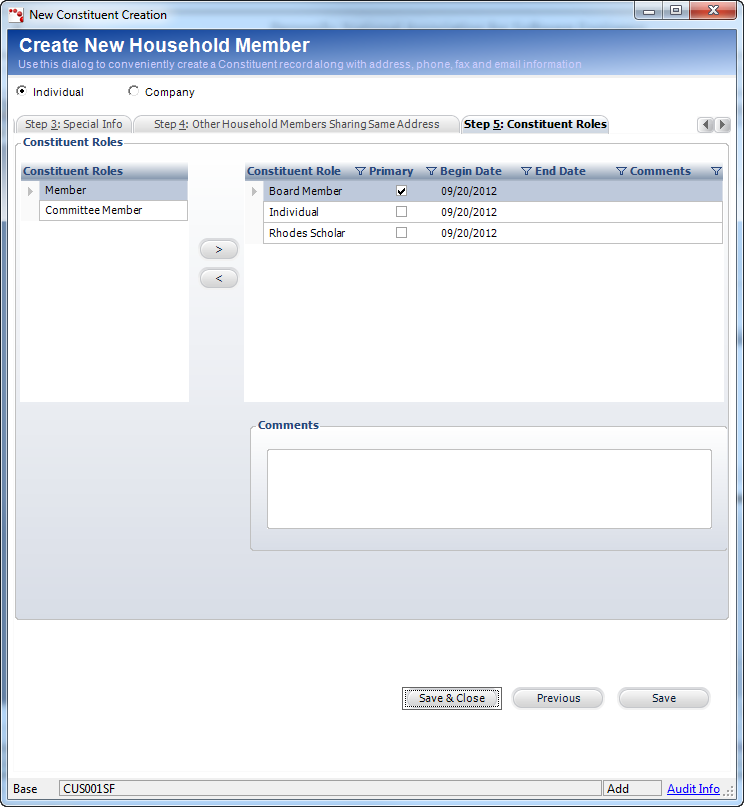
31. Highlight the role code in the Constituent Roles box that you want to assign.
32. Click the right arrow (>) to add the code.
33. Select the End Date in which the role no longer applies.
34. Enter any Comments about the assignment or ending role.
35. Click Save & Close.
The Household Speed Form displays, as shown below.
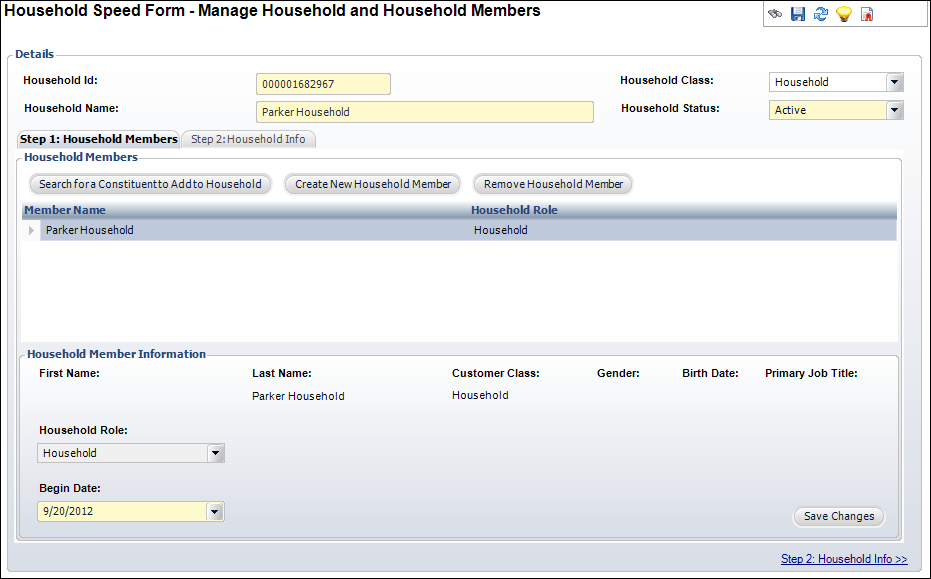
36. From the Household Members section, you can search for constituent to add the household and/or create a new household member. If you do not know any household members at this time, proceed to the next step.
37. Access the Step 2: Household Info tab by clicking the tab or clicking the link at the bottom, right hand side of the screen to add household information.